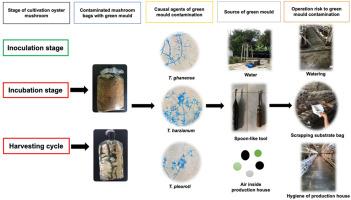马来西亚肺霉菌种植的绿色霉菌污染:揭示致病因子和水源是关键因素。
IF 2.9
3区 生物学
Q2 MYCOLOGY
引用次数: 0
摘要
绿色霉菌污染给马来西亚的蘑菇种植者带来了巨大挑战,导致广泛种植和销售的可食用灰蘑菇(Pleurotus pulmanorius)产量下降和经济损失。本研究旨在确定绿色霉菌污染物的致病因子,并确定农场栽培过程中导致绿色霉菌污染的关键点。在蘑菇栽培的不同阶段收集了蘑菇基质(锯末)、菌种基质(玉米)、环境来源和工具的样本。结果发现,造成绿色霉菌污染的病原菌是胸膜毛霉、哈氏毛霉和加纳毛霉。在蒸汽巴氏灭菌前和蒸汽巴氏灭菌后,发现菌种基质和蘑菇基质都不含毛霉菌。不过,在水、生产车间内的空气和清洁工具上都检测到了毛霉菌。这一发现表明,水可能是蘑菇农场引入绿色霉菌的源头,而采收周期中的浇水和搔抓等栽培方法可能会导致绿色霉菌的产生。了解这些关键点和致病因素可为减轻整个灰蘑菇栽培过程中的绿色霉菌污染提供信息。本文章由计算机程序翻译,如有差异,请以英文原文为准。

Green mould contamination of Pleurotus pulmonarius cultivation in Malaysia: Unravelling causal agents and water source as critical factors
Green mould contamination causes a significant challenge to mushroom growers in Malaysia leading to reduced yields and economic losses in the widely cultivated and marketed edible grey oyster mushroom, Pleurotus pulmanorius. This study aimed to identify the causal agents of green mould contaminants and determine the critical points in the cultivation process in the farm that contribute to green mould contamination. Samples of mushroom substrate (sawdust), spawn substrate (corn), environmental sources and tools were collected at different stages of mushroom cultivation. As results, the causal agents of green mould contamination were identified as Trichoderma pleuroti, T. harzianum and T. ghanese. Prior to steam pasteurisation and after steam pasteurisation, the spawn substrate and mushroom substrate were found to be free of Trichoderma. However, Trichoderma was detected in water, air within the production house and on cleaning tools. This findings suggests that water could serve as the source of green mould introduction in mushroom farms, while cultivation practices such as watering and scratching during the harvesting cycle may contribute to adverse green mould. Understanding these critical points and causal agents provides information to mitigate the green mould contamination throughout the grey oyster mushroom cultivation process.
求助全文
通过发布文献求助,成功后即可免费获取论文全文。
去求助
来源期刊

Fungal biology
MYCOLOGY-
CiteScore
5.80
自引率
4.00%
发文量
80
审稿时长
49 days
期刊介绍:
Fungal Biology publishes original contributions in all fields of basic and applied research involving fungi and fungus-like organisms (including oomycetes and slime moulds). Areas of investigation include biodeterioration, biotechnology, cell and developmental biology, ecology, evolution, genetics, geomycology, medical mycology, mutualistic interactions (including lichens and mycorrhizas), physiology, plant pathology, secondary metabolites, and taxonomy and systematics. Submissions on experimental methods are also welcomed. Priority is given to contributions likely to be of interest to a wide international audience.
 求助内容:
求助内容: 应助结果提醒方式:
应助结果提醒方式:


